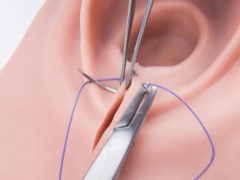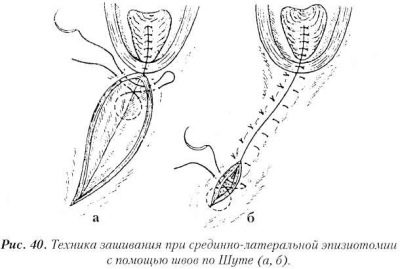What is epiziorrhaphy and when is it used at birth?
Women in preparation for childbirth may encounter a mass of previously unfamiliar medical terms. One of them is episiorrhaphy. In this article, we will describe what the data procedure represents, how it is carried out and why. This will help women better understand the birth process and be more prepared for it.
What it is?
Epiziorrafiya is the compound medical term Episiorrhaphia, which, according to the Big Medical Dictionary in the 2000 edition, contains two concepts: “episode” from Greek means “female external genitalia”, and rhaphe is a “seam”. Thus, it is easy to guess that this term implies surgical procedure for stitching dissected female perineum.
The cut itself is called episiotomy. Such an operation can be carried out in childbirth with the occurrence of prerequisites that allow the doctor to be sure that spontaneous rupture of the perineum can occur without dissection, in which not only the genital tract can be injured, but also the urinary tract and the anus.
During childbirth it is very difficult to calculate something in advance, and therefore an episiotomy may be needed at any time during the second stage of labor, when there are attempts and there are difficulties with the birth of the head or shoulder girdle of the fetus. An incision made in a certain way (one of the existing ones) allows the perineum to be expanded to such a size that the child can be born without suffering severe birth injuries.
When is it held?
Apply epiziorrafii, as you might guess, will be when there is a need to sew a cut made during episiotomy. At the same time, suturing is started only after the completion of childbirth, which is known to end with the birth of the placenta.
If the afterbirth that has come out does not inspire the doctor with any concerns, there is no reason to assume that there are fragments of it in the uterus and that there are ruptures of the cervix, preparation for episiorrhage begins. In all other cases, first eliminate the existing problem. In any case, epiziorrafiya is the final "stroke", after its implementation, childbirth is considered fully completed.
Since the incision can be made either perpendicular to the anus (perrineotomy), or laterally at an angle of 45 degrees at least 2.5 centimeters away from the anus (middle or lateral episiotomy), the incision will be sutured in different directions.
The task of the doctor is to dock the wound edges as accurately as possible and restore their integrity, thereby reducing blood loss and the likelihood of infection getting into the wound.
Performance technique
Starting epiziorrafii, the medical worker first treats his hands with antiseptic. Crotch women treated with chlorhexidine alcohol solution. In this case, this solution is optimal because it reliably disinfects and does not cause alcohol burns.
The doctor puts on sterile gloves, prepares gauze beads for propping through the stitching process. Then proceed to anesthesia. Even if women, as they say, “cut off,” were cut, the perineum would be sutured with anesthesia. Today, the Ministry of Health recommends that the incision be also anesthetized, but most obstetricians are sure that the woman doesn’t feel the moment of the incision, which is carried out at the very peak of another attempt with a single movement of surgical scissors.
Anesthesia suturing after episiotomy can in two ways.
- Infiltration anesthesia involves the introduction of an anesthetic (often "lidocaine") directly into the tissue to be sewn.
- Pudendal Anesthesia involves the introduction of novocaine or other anesthetic into the genital nerve, located about a centimeter proximal to the sciatic bone. Enter the anesthetic can both through the walls of the vagina, and through the perineum.
In both cases, the woman remains conscious, simply does not feel acute pain during manipulation. General intravenous anesthesia can only give if there is a need to extract the placenta manually, suturing the cervix at ruptures. In this case, the final part of the epiziorraphy manipulations does not require separate anesthesia. While the woman is sleeping, she will have time to put all the necessary stitches.
If a woman underwent an epidural anesthesia during childbirth, nothing will be required to prick the perineum, if necessary, an additional anesthetic will be inserted into the catheter in the spinal canal.
For suturing use only sterile tooling.
Suturing begins with a damaged mucous membrane of the posterior vaginal wall. The first seam impose with the top of the cut consistently down. Then with the catgut from the top down in the same direction, the vaginal wall is sutured.
Pelvic floor muscles are usually sutured with catgut. Use the immersion seams along the edges of the dissected muscles. The skin is last sutured - for this purpose, such suture material as vicril threads can be used. You can make a seam and cosmetic, located actually intracutaneously. After the end of suturing, the area is treated with antiseptic once more.
The technique of suturing may be different.
Often, doctors use perioneorrafii according to Shute, when, with seams resembling eights, they immediately fasten all the layers of dissected tissues. The method is quite fast, but, alas, not without reproach - the joints must be removed as the technique does not imply self-absorbable materials. Also, these stitches are most often infected in the early postpartum period. Layer-by-layer closure is considered preferable today.
How the material will be used, what kind of suturing technique the doctor uses will depend on how the seam will heal after delivery.
Possible complications
Crotch - not the most convenient place for sterile dressings and treatment of sutures. In addition, the site of suturing is in contact with copious secretions - lochia. The blood mass can become a breeding ground for pathogenic bacteria and then the seam can become infected, break up, heal for a long time, or form with an anatomical defect.
Compliance with the following recommendations will help to avoid such complications after episiotomy and episiorrhage:
the seams are treated daily with green paint, "air";
sanitary pad or liner used only sterile in the first 2-3 days after birth, change at least once every 2 hours;
need to be washed after each bowel movement or urination;
for 2-3 weeks, one should sit only with support on one hip - from the side opposite to the incision line, one should feed the child and either lie down or stand;
The sutures usually heal within a week, after which they can be removed if they are sewn with silk threads;
after discharge from the hospital, you need to continue to process the seams with green paint;
It is impossible to prevent constipation and other situations in which a woman will have to strain the perineum excessively.
If you find problems with seams, you need to consult a gynecologist, since most of them require treatment.











